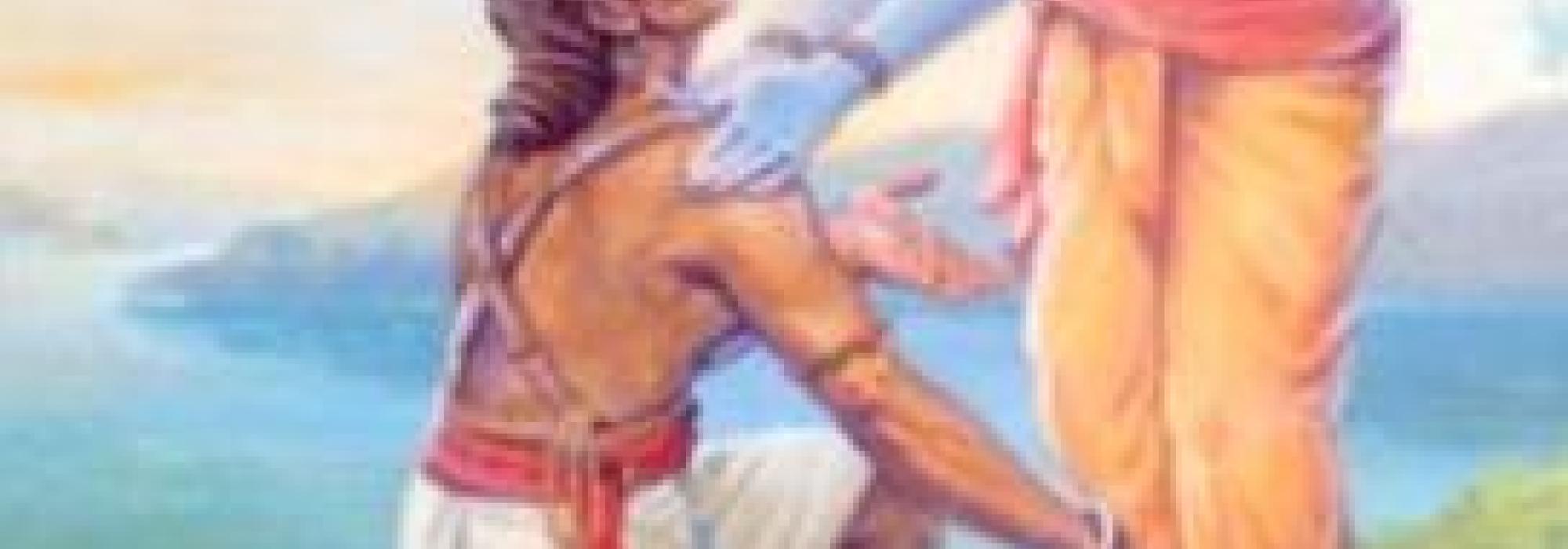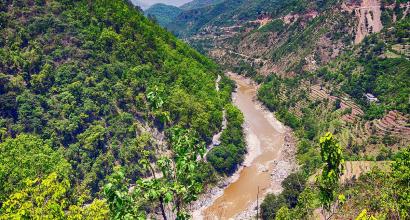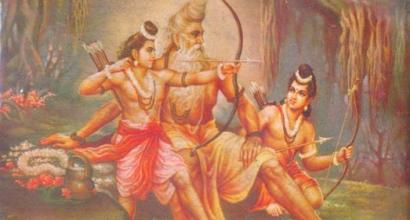As long as the dust raised by Rāma’s chariot was visible, Daśaratha’s height appeared to be increasing, as he strained to catch a last glimpse of his son. He collapsed on the ground when Rāma was no longer visible. The queens Kausalyā and Kaikeyī escorted him to the palace. Daśaratha admonished Kaikeyī, “Don’t touch me! You are neither my queen nor my kin. You are only after wealth! I will soon renounce my life. If Bharata is happy to procure this kingdom, may the tarpaṇa he offered not reach me!” As he entered his house, he wailed, “Alas Rāma! Those who remain alive until Rāma’s return and embrace him upon his arrival are really fortunate! Kausalyā, I cannot see you! my sight that went behind Rāma has not returned!” Kausalyā lamented out of immense grief and felt that even if Rāma has remained as a beggar in the city, it would have been better. She also felt threatened by Kaikeyī who would now possess the entire kingdom. Sumitrā variously consoled her.
~
Though the king was held back, the citizens of Ayodhyā followed Rāma to a large distance. Aged brāhmaṇas, who were triply senior by the virtue of wisdom, years, and tapas, cried out from a distance with their head nodding because of their age, “Dear horses of Rāma! Come back; do what suits best for your master!” Looking at the venerable brāhmaṇas thus lamenting, Rāma got off his chariot and went ahead on foot with Sītā and Lakṣmaṇa. The brāhmaṇas called out, “We will join you to the forest, Rāma, and shield you from the scorching sun with these umbrellas obtained in the Vājapeya-yāga. Our women will continue to live at home protected by their chastity. The tall trees are prevented by their roots from following you, but appear to cry out to you through the wind that sways them! Even the birds sit motionless on tress, instead of searching for food. They implore you to have compassion for all creatures.” Even as they spoke so, the river Tamasā appeared before them, as though to prevent Rāma from proceeding.
It was evening and Rāma spent the night on the banks of Tamasā along with his people. Before the people of Ayodhyā, who had followed him, woke up, Rāma hurried Sumantra to get on to the chariot and lead them away. He felt that it was his duty as a prince to save his people from sorrow and wanted to be away before they woke up and followed him once again. Accordingly, Rāma, Lakṣmaṇa, and Sītā hurried away in the chariot along with Sumantra.
The citizens woke up to find that Rāma had gone away. They were so ravaged by grief as they returned home that they looked as if their very life had deserted them. They stood amidst their wives and children with their faced stained with tears. No mother rejoiced the birth of their first child. In every house, the weeping women blamed their husbands for coming back home without Rāma. They felt that the mountains, forests, and rivers, as well as Lakṣmaṇa and Sītā were fortunate to be in Rāma’s company for ever. They vowed in their sons’ names that they wouldn’t live in the kingdom where Kaikeyī resides.
~
Rāma passed through the country-side of Kosala, where he heard every villager cursing Kaikeyī as well as Daśaratha’s decision. Along with his brother and wife, Rāma crossed over the rivers Vedaśruti, Gomatī, and Syandikā and kept asking Sumantra, “When will I ever reunite with my father and mother? Will I ever be back here to hunt on the banks of River Sarayū?” As he crossed over the Kosala kingdom, he headed towards the Śṛṅgaverapura and arrived at the banks of divine river Gaṅgā. Rāma suggested that they spend the night below a huge and fully blossmed ingudi tree that was close to the river.
The ruler of the region was Guha, who valued Rāma more than his own life. He was the chief of hunters and came to meet Rāma along with his ministers. With tears in his eyes, he embraced Rāma and said, “This place belongs to you entirely, Rāma just as Ayodhyā does.” Guha extended affectionate hospitality, but Rāma did not accept any gifts or comforts as he had pledged to lead the life of a muni. As Rāma and Sītā slept that night, Guha stood guard to them along with Lakṣmaṇa and Sumantra and engaged them in conversation.
Guha offered a comfortable bed to Lakṣmaṇa, who refused to sleep. Lakṣmaṇa said, “No one is dearer to me than Rāma and swear by truth. It is solely through his grace that I would like to gain renown and practice dharma in my life. How can I sleep when he sleeps on the ground with Sītā, much less find rest or cheer? I wonder if father Daśaratha and mothers Kausalyā and Sumitrā will survive this night.” The night wore out as Lakṣmaṇa poured out his heart’s agony and Guha shed tears like an elephant suffering from fever.
The next morning Rāma expressed his wish to cross over the river Gaṅgā at the earliest. As Sumantra bid them farewell, he cursed his destiny which had ordained him to live under the wicked hands of Kaikeyī. Rāma then told him, “The Ikṣvākus will never find another friend as dear as you. Please take care of King Daśaratha such that he does not grieve for me. Once Bharata comes and is anointed as the crown-prince, you will not be overwhelmed by grief for me. Please take care of all our mothers without distinction.” Sumantra spoke with hesitation, “How can I go back to the city with an empty chariot, without you in it, my child? The city will be distraught like an army in battle when it seems the empty chariot of its commander who has met his death. What should I tell the gentle lady, your mother? Should I say, I dropped your son at his maternal uncle’s place, don’t grieve? I will accompany you to the forest, my lord – my horses will happily serve you and have their existence fulfilled. In your company, fourteen years will pass for me like an instant, or else, they will be prolonged a hundredfold.”
Rāma then consoled Sumantra and convinced him to go back. He said, “Only when you go back to the city will our mother Kaikeyī be convinced that Rāma has really gone to the forest and will no longer suspect the king of lying. You should convey all the messages I have given you to those for whom they are intended.”
Upon Rāma’s behest, Guha got him the milky juice of the nyagrodha[1] tree. Rāma matted his locks and Lakṣmaṇa’s with the sap. They clad themselves in bark and piled their matted hair on the top of their heads like ṛṣis. Rāma advised Guha to be ever vigilant regarding his army, treasury, fortress, and inhabited lands and cautioned him that taking care of a kingdom is not an easy task.
Rāma got into the boat, helped Sītā board, and was then joined by Lakṣmaṇa. As the boat was midstream, Vaidehī prayed to Gaṅgā with folded hands and vowed to worship the divine river on their safe return. As they reached the other bank, Rāma instructed Lakṣmaṇa to lead from the front and said that he would follow from the rear with Sītā in the middle. The two men killed many animals included boars and deer and sated their hunger.
That was the first night they were spending in the forest away from the kingdom. After Sītā fell asleep, Rāma spoke to Lakṣmaṇa, “We must keep vigil at night, for Sītā’s safety depends on us. Our father, the king, will certainly find it hard to sleep tonight. Old, helpless, and separated from me, I wonder how the man, who is now a slave of passion, survive under Kaikeyī’s power! Looking at the incidents of the recent days, I am convinced that kāma is more powerful than dharma and artha. May our dear mother Sumitrā not suffer because of me. Go back, Lakṣmaṇa! I will go alone with Sītā to the forest! My dear mother Kausalyā, who nourished me for so long, is indeed unfortunate!” Lakṣmaṇa consoled his older brother and said neither he, nor Śatrughna nor their father would even desire svarga without Rāma.
~
The next morning, they set out and walked through several forests and country sides. As the day was drawing to a close, Rāma pointed towards smoke at a distance and also the sound of clashing of waters, indicating that they were close to Bharadvāja’s āśrama at the confluence of Gaṅgā and Yamunā. They also observed logs of wood hewn by foresters and different kinds of trees around the āśrama. Animals and birds got frightened at their appearance. They introduced themselves to Sage Bharadvāja, who reverentially welcomed them. The sage pointed them to a peaceful spot where they could stay, but Rāma refused saying that if they lived there, people would frequently visit them. Bharadvāja then advised them to head to reside in Citrakūṭa. They spent the night in the āśrama.
The next morning, Bharadvāja told them the route and about the huge, divine banyan tree called Śyāma on the other shore of the river Yamunā. They bid farewell, walked further, and made a small raft to cross over the river. Rāma carried his beloved Sītā, who was slightly bashful on to the raft and they crossed the river. Once they arrived at the cool, green Banyan tree Śyāma, Sītā, as instructed by Sage Bharadvāja went around the tree with her hands folded. She prayed. “May I be blessed to see Kausalyā and Sumitrā again!” They happily spent the day and retired at a peaceful spot.
To be continued...
[The critically constituted text and the critical edition published by the Oriental Institute, Vadodara is the primary source. In addition, the Kannada rendering of the epic by Mahāmahopādhyāya Sri. N. Ranganatha Sharma and the English translation by Sri. N. Raghunathan have been referred.]
[1] Indian fig tree/ banyan tree











































